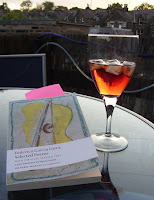A Drinks Host's Guide
There’s a strong culture of aperitifs in much of Europe.
Each country has its favourite drink or drinks that are served with a little
food before dinner. Think of that spritz you enjoyed so much in Venice or the
Pastis you were persuaded to drink with just water in Nice, or that cool, dry
sherry you had in Madrid. What all of these drinks have in common is that
they’re all on the strong side, and each has its own, very distinctive taste.
 |
| a bitter orange 'vin cuit' in Yorkshire - not quite Lake Como! |
On the other hand, there are a number of traditional
aperitif drinks that are very dry and sharp. Fino sherry falls into this
category, as does Champagne. Where the bitter drinks have a strong flavour, the dry, sharp ones are more likely to seem a bit reserved. What these drinks are
doing is stimulating the production of saliva, so that your mouth is ready to
make the most of the flavours it’s
about to experience.
Experience has taught that a good aperitif drink stands in
contrast in some way to the wine I’ll be serving with the starter. If the
starter demands a bone-dry Chablis, I serve a sweet drink en apéritif. If it suits a sweeter wine, I serve Champagne or a
sharp cocktail such as a White Lady. If I’m serving a giddy, fizzy wine with
the starter, I’m going to be more serious in my aperitif, maybe a simple
sherry, Madeira or tawny port.
I never rely on “what I’ve got in” when serving an aperitif for a dinner party, always planning the aperitif with the rest of the menu. However, there are many days and dinners where we haven’t planned anything elaborate, and I do like to keep a couple of bottles I can reach for whenever I’m in the mood. My general preference is to match the drink to the season. After the dark and damp of a Yorkshire winter, what I’m craving is frivolity, so spring is my time for cocktails. Summer brings on my desire for refreshing drinks like G&T, Pastis, lighter vermouths and spritz. Early autumn calls for fruit drinks like Kir, but when the winds set in and the leaves are falling, I’m after the fortified wines, sweet vermouths and tonic wines like Byrrh or Dubonnet. Which brings me back to the bleak midwinter, when there’s nothing for it but to cheer oneself up with Champagne!




Comments
Post a Comment